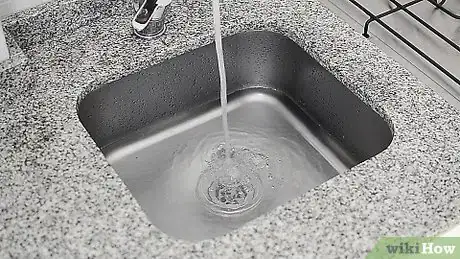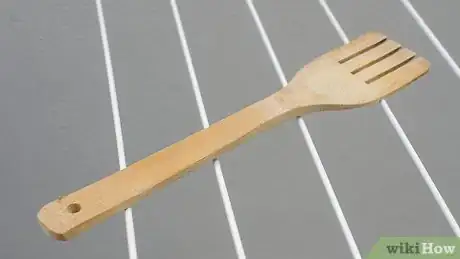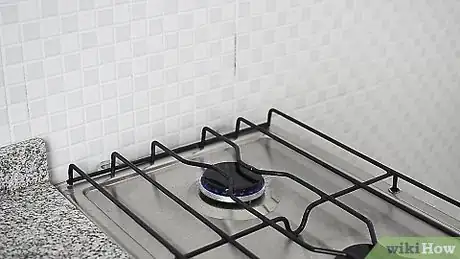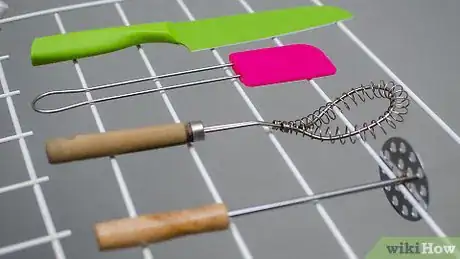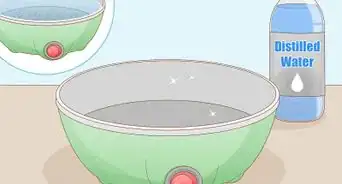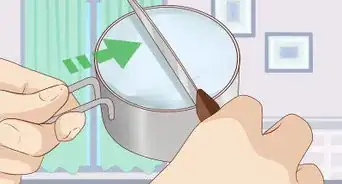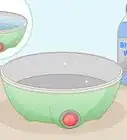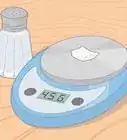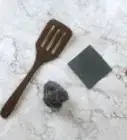X
This article was co-authored by Melanie Garcia. Melanie Garcia is the Co-Owner of Oranges & Lemons, a small, family cleaning business based in Downtown Los Angeles, California (DTLA) in operation for over 40 years. Oranges & Lemons operates while partnering with the National Domestic Workers Alliance and Hand in Hand: Domestic Employers Network.
This article has been viewed 26,560 times.
Utensils are quick and easy to clean. Simply wash the utensils with hot water and soap, or use the natural cleaning power of the sun, salt, and lemon if you’re cleaning wooden utensils. If you want to sterilise the utensils, try soaking them in boiling water. Before you know it your utensils will be sparkling clean.
Steps
Method 1
Method 1 of 3:
Washing Utensils by Hand
-
1Scrape any excess food into the bin with a paper towel. Leftover food will make the water dirty and cause it to be less effective. Use a paper towel to wipe off any big chunks of food that are stuck to the utensil.[1]
- Don’t worry about removing small bits of food as this can be removed when you are washing the utensil.
-
2Fill your kitchen sink with hot water and dishwashing liquid.[2] Put the plug in the sink and turn on the hot tap. As the sink sink is filling up with water, squeeze about 1 tablespoon (15 grams) of dishwashing liquid into the water.[3]
- Read the label of the dishwashing liquid bottle to find the correct amount of liquid to use as some concentrated detergents won’t require as much.
Advertisement -
3Add 2 tbsp (30 grams) of baking soda to the water for some extra cleaning power. If you are a looking for a natural cleaner, baking soda is a great option. The powder will help to reduce smells and break down stains. Add the baking soda to your sink of water and dishwashing liquid and mix everything together.[4]
-
4Put the utensils in the sink and scrub off the food with a dish brush. Place the least soiled utensils into the sink first. This will stop the water from becoming too dirty. Scrub each utensil with a dish brush until all of the food has been removed. Once the utensil is clean, place it onto a drying rack.[5]
-
5Leave the utensils to soak if the food is stuck on. If the food isn’t coming off the utensil, leave it to soak in the sink while you wash the rest of the dishes. This will cause the food to loosen its grip on the utensil. Try scrubbing it again once all the other dishes have been washed.[6]
- If necessary, use a dish scourer to remove any remaining food from the utensils.
-
6Dry the utensils with a tea towel or leave them to air dry. Dry each utensil individually with a tea towel and return them to their drawer. Alternatively, leave the utensils on the drying rack to dry naturally. This option is easy and avoids stainless steel utensils getting a smeary look.[7]
- If you are air drying your utensils, make sure that they aren’t stacked on top of each other as this will stop the air circulating and drying them.
Advertisement
Method 2
Method 2 of 3:
Cleaning Wooden Utensils
-
1Scrub the utensil with hot soapy water. Use a scrubbing brush to remove any surface food from the wooden item. Don’t be alarmed if there are stains under the food - this is normal for wooden utensils.[8]
- It is important to use hot soapy water as this will help to remove any bacteria that has soaked into the wood.[9]
-
2Use a cut lemon to rub coarse salt over the utensil. Cut a fresh lemon in half and cover it with coarse salt. Rub the lemon over the utensil until all of the salt has dissolved. The natural cleaning properties of the salt and lemon will help to remove any smells and stains from the utensil.[10]
- If the wooden utensil is still stained, scrub 1 tsp (5 grams) of baking soda and a few drops of lemon juice into the stain. This should help to lift out the rest of the stain.
-
3Rinse the utensil with cold water. Hold the utensil under running water until all the lemon juice and salt has washed off. If necessary, use a dishcloth to help push off the salt.[11]
-
4Leave the utensil to dry in the sun. The sun will help to fade any old or residual stains on your wooden utensil. Leave the utensil in the sun until it has dried. This should take about 1 hour, depending on the temperature outside.[12]
- If it isn’t sunny outside, leave the utensil to air dry inside and place it outside on a sunny day to fade any stains.[13]
Advertisement
Method 3
Method 3 of 3:
Sterilizing Utensils
-
1Fill a large pot with water and bring it to a boil. Use enough water to cover all the utensils that you want to sterilise. Place a lid on the pot to help the water boil faster. The boiling water will kill any bugs or bacteria that are on the utensils leaving them sparkling clean and hygienic.[14]
-
2Place the utensils in the boiling water for 10 minutes. Carefully place all the utensils into the pot of boiling water and make sure that all the utensils are covered. If necessary, add extra water to cover any utensils that are sticking out of the water. Keep the pot on the stovetop so that the water continues to boil.[15]
- Turn down the heat if the water is bubbling over the sides of the pot.
-
3Remove the utensils from the water. Turn the heat off the stovetop and use a pair of clean tongs to carefully remove the utensils from the water and place them onto a clean drying rack. Be careful not to touch the utensils as they will be burning hot.[16]
- Transfer 1 utensil at a time to avoid accidentally dropping them.
-
4Leave the utensils on a drying rack for 1 hour. Air-drying is the most hygienic way to dry dishes as there is no contamination from a towel. Arrange the utensils so that they aren’t touching each other. This will help the air to circulate around the dishes and help them to dry faster.[17]
Advertisement
Expert Q&A
-
QuestionHow do you disinfect wooden utensils naturally?
 Melanie GarciaMelanie Garcia is the Co-Owner of Oranges & Lemons, a small, family cleaning business based in Downtown Los Angeles, California (DTLA) in operation for over 40 years. Oranges & Lemons operates while partnering with the National Domestic Workers Alliance and Hand in Hand: Domestic Employers Network.
Melanie GarciaMelanie Garcia is the Co-Owner of Oranges & Lemons, a small, family cleaning business based in Downtown Los Angeles, California (DTLA) in operation for over 40 years. Oranges & Lemons operates while partnering with the National Domestic Workers Alliance and Hand in Hand: Domestic Employers Network.
Professional House Cleaner To disinfect wooden utensils naturally, fill a spray bottle with water and vinegar. Place the utensils on a paper towel and spray them with the water and vinegar mixture. After, let the utensils air dry.
To disinfect wooden utensils naturally, fill a spray bottle with water and vinegar. Place the utensils on a paper towel and spray them with the water and vinegar mixture. After, let the utensils air dry.
Advertisement
References
- ↑ https://www.cleaninginstitute.org/clean_living/hand_dishwashing_steps.aspx
- ↑ Melanie Garcia. Professional House Cleaner. Expert Interview. 10 October 2019.
- ↑ https://www.cleaninginstitute.org/clean_living/hand_dishwashing_steps.aspx
- ↑ https://brendid.com/non-toxic-homemade-dish-detergent-for-hand-washing/
- ↑ https://www.cleaninginstitute.org/clean_living/hand_dishwashing_steps.aspx
- ↑ https://www.cleaninginstitute.org/clean_living/hand_dishwashing_steps.aspx
- ↑ https://www.cleaninginstitute.org/clean_living/hand_dishwashing_steps.aspx
- ↑ https://www.cookinglight.com/cooking-101/techniques/how-to-clean-wooden-kitchen-utensils
- ↑ Melanie Garcia. Professional House Cleaner. Expert Interview. 10 October 2019.
- ↑ https://www.cookinglight.com/cooking-101/techniques/how-to-clean-wooden-kitchen-utensils
- ↑ https://www.cookinglight.com/cooking-101/techniques/how-to-clean-wooden-kitchen-utensils
- ↑ https://www.cookinglight.com/cooking-101/techniques/how-to-clean-wooden-kitchen-utensils
- ↑ Melanie Garcia. Professional House Cleaner. Expert Interview. 10 October 2019.
- ↑ https://www.ag.ndsu.edu/flood/home/disinfecting-dishes-cookware-and-utensils
- ↑ https://www.ag.ndsu.edu/flood/home/disinfecting-dishes-cookware-and-utensils
- ↑ https://www.ag.ndsu.edu/flood/home/disinfecting-dishes-cookware-and-utensils
- ↑ https://www.ag.ndsu.edu/flood/home/disinfecting-dishes-cookware-and-utensils
About This Article
Advertisement
